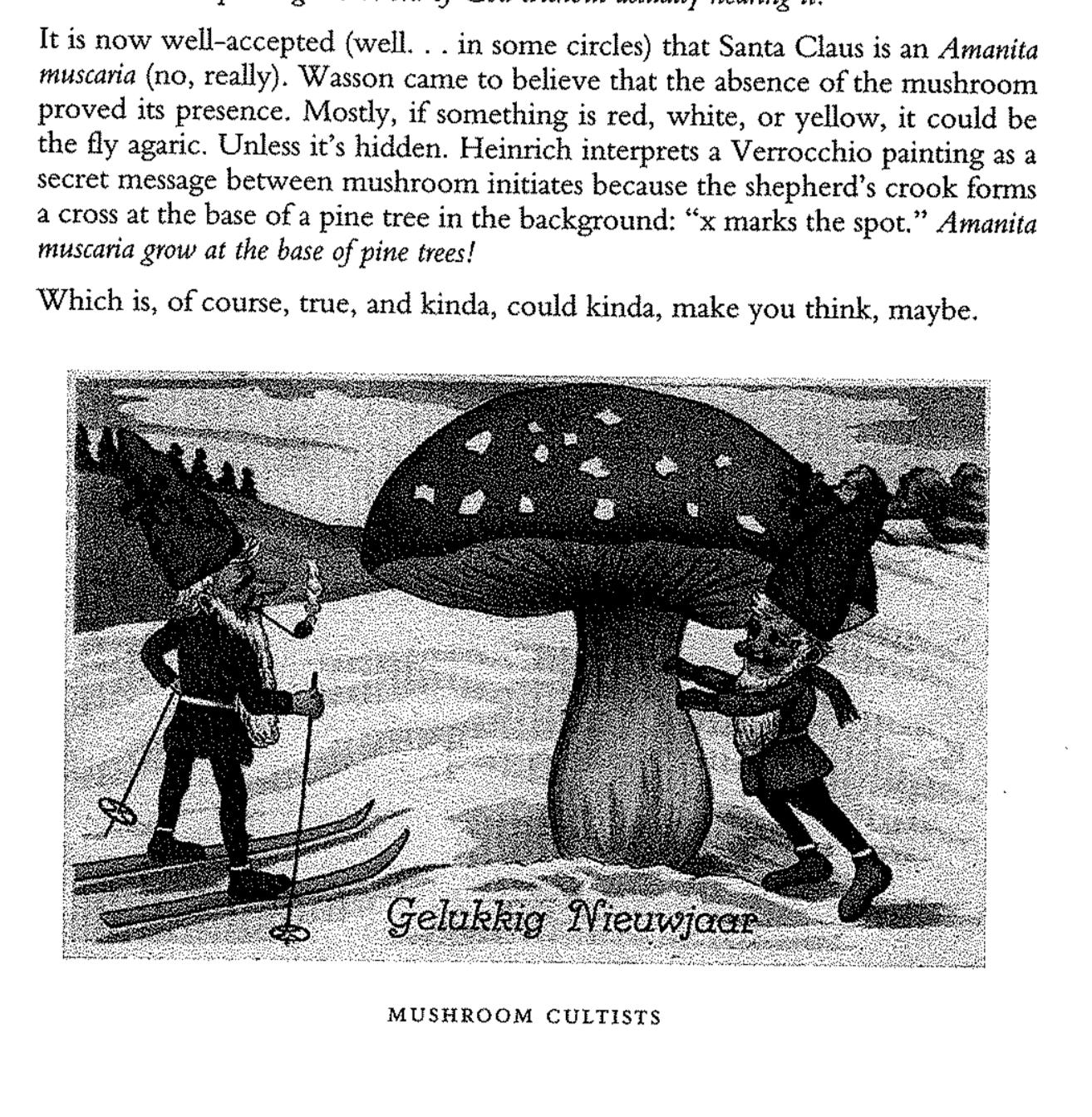Slater, Lauren. "How psychedelic drugs can help patients face death." NY Times (2012).
http://www.nytimes.com/2012/04/22/magazine/how-psychedelic-drugs-can-help-patients-face-death.html
Once the drug took effect, Reamer lay there and rode the music’s dips and peaks. Reamer said that her mind became like a series of rooms, and she could go in and out of these rooms with remarkable ease. In one room there was the grief her father experienced when Reamer got leukemia. In another, her mother’s grief, and in another, her children’s. In yet another room was her father’s perspective on raising her. “I was able to see things through his eyes and through my mother’s eyes and through my children’s eyes; I was able to see what it had been like for them when I was so sick.”
If psilocybin can so reliably induce these life-altering experiences, why have the hundreds of thousands of Americans who have taken magic mushrooms recreationally not had this profound experience? Grob explains that in addition to the carefully controlled setting of these studies and the opportunity to process the experience with the researchers, the subjects are primed for transcendence before they even take the drug. “Unlike the recreational user, we process the experience ahead of time,” Grob says. “We make it very clear up front that the hoped-for outcome is therapeutic, that they’ll have less anxiety, less depression and a greater acceptance of death.” Subjects, in other words, intend to have a transformative experience. Grob says that psilocybin taken in this setting is “existential medicine.”
Perhaps end-stage cancer patients are able to capture enduring benefits of psilocybin precisely because they are processing their drug experiences again and again with research staff and in doing so are changing the way the brain encodes positive memories. The phenomenon might be similar to how other memories work; when we remember something sweet-smelling, the olfactory neurons in our brain start to stir; when we remember running, our motor cortex begins to buzz. If this is the case then merely recalling the trip could resurrect its neural correlates, allowing the person to re-experience the insight, the awareness, the hope.
Griffiths continued: “When you make people less afraid to die, then they’re less likely to cling to life at a huge cost to society. After having such a transcendent experience, individuals with terminal illness often show a markedly reduced fear of dying and no longer feel the need to aggressively pursue every last medical intervention available. Instead they become more interested in the quality of their remaining life as well as the quality of their death.”
In a future still far off, Grob imagines retreat centers where the dying could have psilocybin administered to them by a staff trained for the task. Doblin asks: “Why confine this to just the dying? This powerful intervention could be used with young adults who could then reap the benefits of it much earlier.” The subjects who have undergone psilocybin treatment report an increased appreciation for the time they have left, a deeper awareness of their roles in the cycle of life and an increased motivation to invest their days with meaning. “Imagine allowing young adults, who have their whole lives in front of them, access to this kind of therapy,” Doblin says. “Imagine the kind of lives they could then create.”
If David Nutt, in Britain, is able to prove the efficacy of psilocybin for treatment-resistant depression, would the F.D.A. ever consider approving it for that use? And if that ever were to happen, what sort of slippery slope would we find ourselves on? If, say, end-stage cancer patients can have it, then why not all individuals over the age of, say, 75? If treatment-resistant depressives can have it, then why not their dysthymic counterparts, who suffer in a lower key but whose lives are clearly compromised by their chronic pain? And if dysthymic individuals can have it, then why not those suffering from agoraphobia, shut up day and night in cramped quarters, Xanax bottles littered everywhere?
Besides, Grob told me, scientists are still at the very early stages of this research. “Twelve people,” he says of the size of his study. “One study with 12 people is not very definitive.” And yet, talking to him, you can hear a hint of excitement, something rising. “We saw remarkable and sustained changes in cancer patients’ spiritual dispositions. People’s entire sense of who they are has been altered in a positive manner.” He is looking forward to the day, he told me, when Griffiths and Ross “crunch their numbers” from their current studies. Grob says, “From what they say they’re seeing, it all sounds very positive.” Perhaps, then, we need not understand precisely how and why psilocybin works, accepting, as Halpern puts it, that “when you combine the chemical, the corporeal and the spiritual, you get a spark. You get magic.”
Bone, Eugenia. "Can Mushrooms Treat Depression?" NY Times (2014)
http://www.nytimes.com/2014/11/30/opinion/sunday/can-mushrooms-treat-depression.html
A study published last month in the Journal of the Royal Society Interface compared M.R.I.s of the brains of subjects injected with psilocybin with scans of their normal brain activity. The brains on psilocybin showed radically different connectivity patterns between cortical regions (the parts thought to play an important role in consciousness). The researchers mapped out these connections, revealing the activity of new neural networks between otherwise disconnected brain regions.
The researchers suspect that these unusual connections may be responsible for the synesthetic experience trippers describe, of hearing colors, for example, and seeing sounds. The part of the brain that processes sound may be connecting to the part of the brain that processes sight. The study’s leader, Paul Expert at King’s College London, told me that his team doubted that this psilocybin-induced connectivity lasted. They think they are seeing a temporary modification of the subject’s brain function.
The fact that under the influence of psilocybin the brain temporarily behaves in a new way may be medically significant in treating psychological disorders like depression. “When suffering depression, people get stuck in a spiral of negative thoughts and cannot get out of it,” Dr. Expert said. “One can imagine that breaking any pattern that prevents a ‘proper’ functioning of the brain can be helpful.” Think of it as tripping a breaker or rebooting your computer.
A range of studies have suggested that controlled doses of psilocybin can help the user escape cognitive ruts of all sorts. One study, published in the British Journal of Psychiatry in 2012, rated the vividness of autobiographical memory of subjects on psilocybin and found the drug enhanced their recollection, and “subjective well-being” upon follow-up. The researchers concluded that psilocybin might be useful in psychotherapy as an adjunct therapy to help patients reverse “negative cognitive biases” — a phenomenon common in depression by which one has a greater recall of negative memories than positive ones — and facilitate the recall of important memories.
Don’t get me wrong: I’m not suggesting 16-year-olds take magic mushrooms. I’m not suggesting they be used to party at all. What I am advocating for is a mind open to the possibilities of their use to help people in need. Because illiberality doesn’t cure disease; curiosity does.
Claire Evans, "Livin' in a Mycelial World" Science Blogs, 2011
http://scienceblogs.com/universe/2011/07/17/living-in-a-mycelial-world/
a visualization of the network structure of the Internet by Hal Burch and Bill Cheswick, courtesy of Lumeta Corporation.
Stamets, who calls mycelium “Earth’s Natural Internet,” puts it this way:
I believe the invention of the computer Internet is an inevitable consequence of a previously proven biologically successful model. The earth invented the computer internet for its own benefit, and we, now, being the top organism on this planet, [are] trying to allocate resources in order to protect the biosphere.
Going way out, dark matter conforms to the same mycelial archetype. I believe matter begets life, life becomes single cells, single cells become strings, strings become chains, chains network. And this is the paradigm that we see throughout the universe.
Mycelium, an intertwined network of cells permeating virtually all land masses of Earth, is not something to take lightly. It literally engulfs the soil beneath us in a sentient web, rising up beneath our footsteps, hungry for nutrients. There is something beautiful and horrifying, ancient and keenly technological about these organisms, a complexity it may take a psychedelically-informed, non-institutional mind to fully appreciate.








